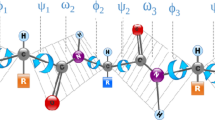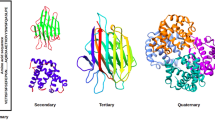Abstract
This article discusses the advantages and problems of different approaches to ab initio protein structure prediction. Recent successful approaches based on deep learning are compared with those based on protein fragment replacements and energy minimization with different search strategies, including ours based on evolutionary algorithms. Selected proteins are considered to analyze the approaches, focusing on the problems of those based on deep learning.
This study was funded by the Xunta de Galicia and the European Union (European Regional Development Fund - Galicia 2014–2020 Program), with grants CITIC (ED431G 2019/01), GPC ED431B 2019/03 and IN845D-02 (funded by the “Agencia Gallega de Innovación”, co-financed by Feder funds, supported by the “Consellería de Economía, Empleo e Industria” of Xunta de Galicia), and by the Spanish Ministry of Science and Innovation (project PID2020-116201GB-I00).
Access this chapter
Tax calculation will be finalised at checkout
Purchases are for personal use only
Similar content being viewed by others
References
AlphaFold2 server. https://colab.research.google.com/github/sokrypton/ColabFold/blob/main/AlphaFold2.ipynb
RoseTTAFold server. https://colab.research.google.com/github/sokrypton/ColabFold/blob/main/RoseTTAFold.ipynb
Baek, M., DiMaio, F., Anishchenko, I., et al.: Accurate prediction of protein structures and interactions using a three-track neural network. Science 373(6557), 871–876 (2021). https://doi.org/10.1126/science.abj8754
Protein structure prediction center. http://predictioncenter.org/
Evans, R., et al.: De novo structure prediction with deep-learning based scoring. In: 13th Critical Assessment of Techniques for PSP, pp. 1–4 (2018)
Garza-Fabre, M., Kandathil, S., Handl, J., Knowles, J., Lovell, S.: Generating, maintaining, and exploiting diversity in a memetic algorithm for protein structure prediction. Evol. Comput. 24(4), 577–607 (2016)
Prediction results of the SARS-CoV-2 unsolved proteins. https://www.dc.fi.udc.es/ir/in845d-02/SARS-CoV-2_protein_prediction/index.html
Jumper, J., Evans, R., Pritzel, A., et al.: Highly accurate protein structure prediction with AlphaFold. Nature 596, 583–589 (2021). https://doi.org/10.1038/s41586-021-03819-2
Kaufmann, K., Lemmon, G., DeLuca, S., Sheehan, J., Meiler, J.: Practically useful: what the Rosetta protein modeling suite can do for you. Biochemistry 49, 2987–2998 (2010). https://doi.org/10.1021/bi902153g
Protein Data Bank. http://www.wwpdb.org
Price, K., Storn, R., Lampinen, J.: Differential evolution. A practical approach to global optimization (2005)
Rohl, C., Strauss, C., Misura, K., Baker, D.: Protein structure prediction using Rosetta. Meth. Enzymol. 383, 66–93 (2004). https://doi.org/10.1016/S0076-6879(04)83004-0
Rosetta system. http://www.rosettacommons.org
Santos, J., Diéguez, M.: Differential evolution for protein structure prediction using the HP model. In: Ferrández, J.M., Álvarez Sánchez, J.R., de la Paz, F., Toledo, F.J. (eds.) IWINAC 2011. LNCS, vol. 6686, pp. 323–333. Springer, Heidelberg (2011). https://doi.org/10.1007/978-3-642-21344-1_34
Senior, A., Evans, R., Jumper, J., et al.: Improved protein structure prediction using potentials from deep-learning. Nature 577, 706–710 (2020). https://doi.org/10.1038/s41586-019-1923-7
Varela, D., Santos, J.: A hybrid evolutionary algorithm for protein structure prediction using the face-centered cubic lattice model. In: Liu, D., **e, S., Li, Y., Zhao, D., El-Alfy, E.S. (eds.) Neural Information Processing, ICONIP 2017. Lecture Notes in Computer Science, vol. 10634. Springer, Cham (2017). https://doi.org/10.1007/978-3-319-70087-8_65
Varela, D., Santos, J.: Crowding differential evolution for protein structure prediction. In: Ferrández Vicente, J.M., Álvarez-Sánchez, J.R., de la Paz López, F., Toledo Moreo, J., Adeli, H. (eds.) IWINAC 2019. LNCS, vol. 11487, pp. 193–203. Springer, Cham (2019). https://doi.org/10.1007/978-3-030-19651-6_19
Varela, D., Santos, J.: Protein structure prediction in an atomic model with differential evolution integrated with the crowding niching method. Nat. Comput., 1–15 (2020). https://doi.org/10.1007/s11047-020-09801-7
Yang, J., Anishchenko, I., Park, H., Peng, Z., Ovchinnikov, S., Baker, D.: Improved protein structure prediction using predicted interresidue orientations. PNAS 117, 1496–1503 (2020). https://doi.org/10.1073/pnas.1914677117
Author information
Authors and Affiliations
Corresponding author
Editor information
Editors and Affiliations
Rights and permissions
Copyright information
© 2022 Springer Nature Switzerland AG
About this paper
Cite this paper
Filgueiras, J.L., Varela, D., Santos, J. (2022). Energy Minimization vs. Deep Learning Approaches for Protein Structure Prediction. In: Ferrández Vicente, J.M., Álvarez-Sánchez, J.R., de la Paz López, F., Adeli, H. (eds) Bio-inspired Systems and Applications: from Robotics to Ambient Intelligence. IWINAC 2022. Lecture Notes in Computer Science, vol 13259. Springer, Cham. https://doi.org/10.1007/978-3-031-06527-9_11
Download citation
DOI: https://doi.org/10.1007/978-3-031-06527-9_11
Published:
Publisher Name: Springer, Cham
Print ISBN: 978-3-031-06526-2
Online ISBN: 978-3-031-06527-9
eBook Packages: Computer ScienceComputer Science (R0)




